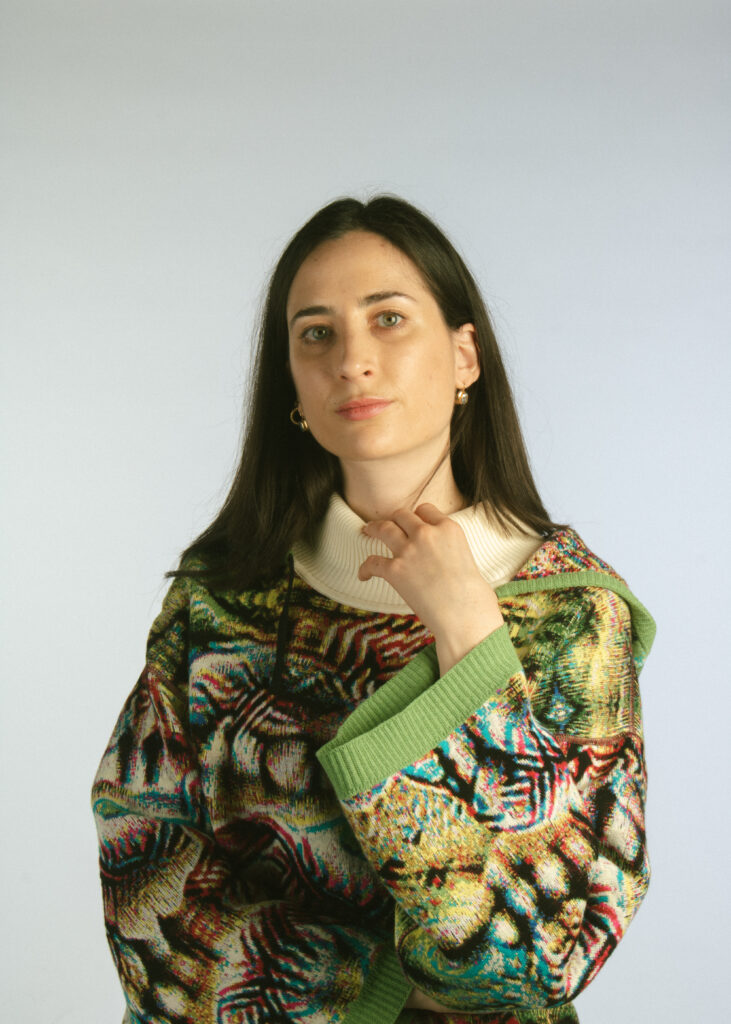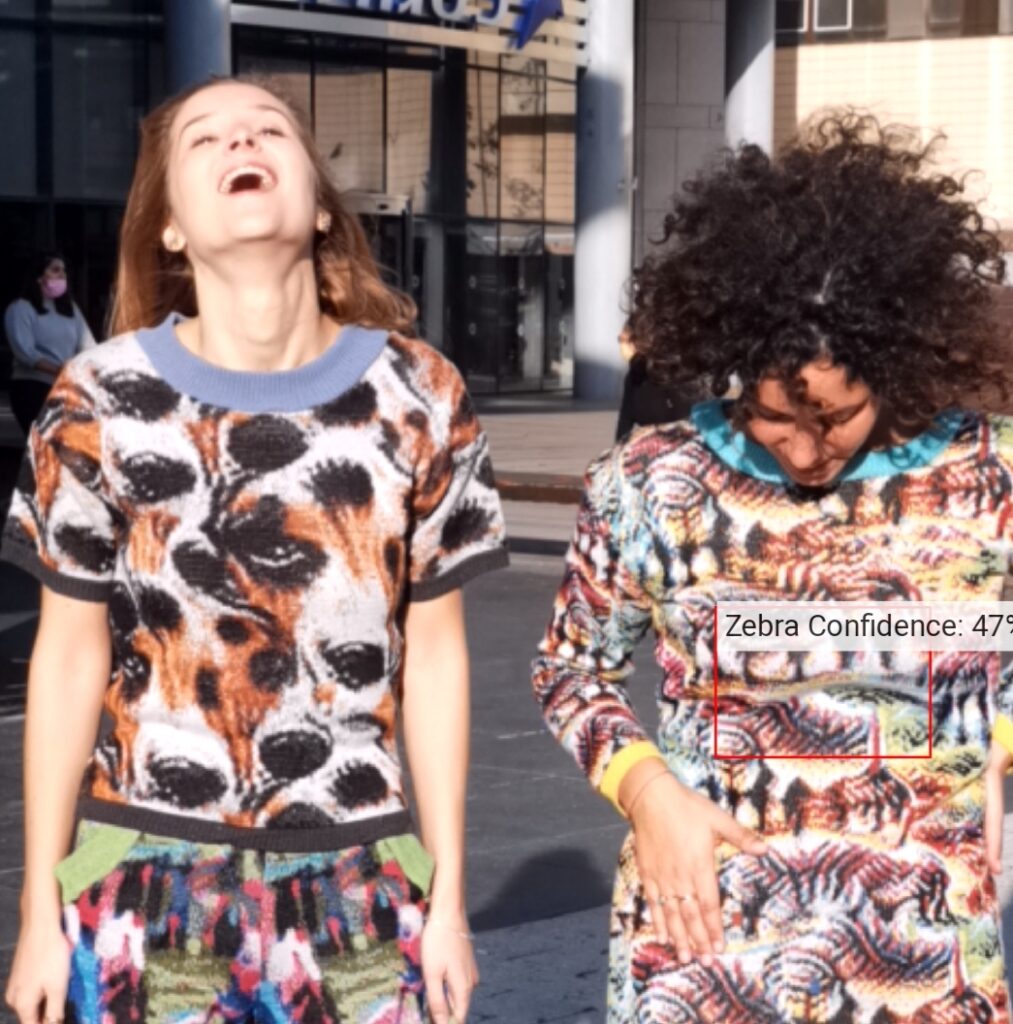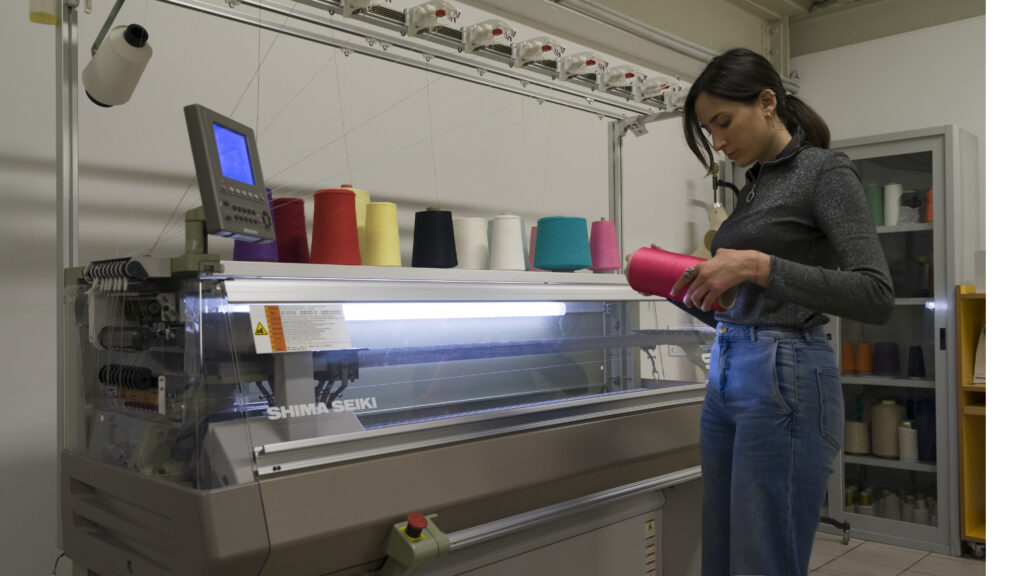Rachele Didero attended grammar school (Liceo Classico) in Turin and spent the fourth year at a high school in Montana, and there she took her first sewing course. She then enrolled at the Politecnico di Milano, in the Laurea (BSc) programme in Fashion Design, then she continued with a Laurea Magistrale (MSc) programme in Design for the Fashion System, also at the Politecnico. During her university years, thanks to support from the Politecnico, she had the opportunity to travel a lot and study between Milan, Barcelona, New York and Tel Aviv.
It was in New York that she first heard about biometric recognition cameras and the social issues linked to this technology. To date, she is continuing her research with a PhD programme, still at the Politecnico di Milano, at the Department of Design, as a member of the research group of the Knitwear Design Lab led by Professor Giovanni Maria Conti. She cooperates with the DEIB (Department of Electronics, Information Science and Bioengineering), in particular with Professor Giacomo Boracchi’s research group.
How did you discover the world of fashion? Did you breathe it in your family or was it a personal journey of yours?
It was a gradual process. I believe that, as an Italian, I have always been in touch with the culture of the “Bello e Ben Fatto” (BBF, Beautiful and Well-made). As a child, my grandmother used to let me play with her scarves, and my sister and me have always had a sort of ‘costume shop’ for our plays where we collected everything from carnival costumes to dance recital ones. My Mum is an architect and used to take me to museums and exhibitions. I was brought up that way and this creativity led me to the world of textiles and fashion. Then, in 2015 I decided to see whether this passion could become my job one day.

How did you come up with the idea of protecting our personal identity by creating a fabric that prevents facial recognition
This idea was born in 2019 in New York, while discussing with some friends about a black community in Brooklyn that had won a lawsuit against the apartment complex where they lived, precisely because biometric recognition cameras had been installed at the entrance of the building. Among my friends there was a computer science engineer who told me about particular images that are able to trick biometric recognition algorithms, so we decided to create protective garments. We chose to use knitted fabric as it is the only one that has the required characteristics, and also based on that which I had learnt in my third year specialization at the Politecnico.
What is biometric data?
Biometric data is personal data linked to our physical, physiological and behavioural characteristics. This data allows to unambiguously identify each individual and accompanies each of us throughout our lives, and we cannot change it.
Examples of biometric data are fingerprints, the iris, DNA and the facial signature, which is a biometric calculation of our face based on the distance detected between our eyes, eyebrows, nostrils… We can have the same name as someone else, or we can choose to change our name, but we can never have the same fingerprint as someone else or change it.
Linking the detected biometric data to a database allows to find our personal data, such as name, address, family relations and so on. Detection of our facial biometric data often occurs without us even being aware of it, as we do not see the facial recognition cameras installed and working in public spaces or in private spaces open to the public».
How can you trick an algorithm?
Let’s imagine these garments as QR codes that protect us instead of giving out information on us. They send object recognition systems so many inputs in real-time that the systems get confused and fail to identify the one wearing garments as a ‘person’. The technological innovation behind this project lies in the creation of a system capable of transposing images (called adversarial patches) onto a knitted fabric that can be used to deceive people detectors in real time. By wearing a garment in which an adversary image is woven, you can protect you facial biometric data, as it becomes non-detectable or is associated with an incorrect category such as ‘animal’ instead of ‘person’.
Until now, adversarial patches have only been printed. The method patented by that Cap_able makes it possible to embed the algorithm into the fabric texture in such a way that the garments fit your body perfectly while effectively protecting your biometric data.
This fabric was tested with YOLO, the most common and fastest real-time object detection system. YOLO is not able to recognise people wearing Cap_able garments as people, but is able to identify dogs, zebras or giraffes within the fabric.

How much technology is there in these garments?
The garments in the Manifesto Collection are entirely knitted and produced in Italy using complex industrial processes. For example, it takes seven hours to knit the various parts of a hoodie, which are then cut by hand and also assembled by hand. The electronic knitting machines required to manufacture these garments are highly complex and are the only ones capable of manufacturing the fabrics created using this patented technology, which is the outcome of more than three years of research. The end result is a unique, premium quality piece of design and technology.
We are a start-up committed to sustainability at all levels. This means that we do our best to limit our environmental impact. Therefore, the materials used to produce our garments comply with the highest quality standards and come from certified manufacturers who guarantee the best possible conditions for their workers.

Why the collection name “Manifesto”?
It features colourful patterns that are intended to be the Manifesto of a movement, the Manifesto of change. These colourful patterns make us invisible to Artificial Intelligence – which is almost ironical -, but at same time, they make us highly visible to other humans, and thus convey a clear message aimed to raise awareness of the importance of human rights and of understanding the risks associated with mass surveillance.
Don’t you risk being accused of protecting the ill-intentioned? To give them an invisibility cloak?
This technology is completely legal, as it does not hide your face and allows other people to recognise and identify you at any time.
There is no, and it would not be compatible with the current constitutional framework, a generalised duty on the part of those who circulate freely in public or or open spaces, to have their biometric data collected indiscriminately by automated facial recognition tools. Using the products that CAPABLE intends to produce and market means legitimately exercising fundamental rights that are protected by the constitution in most democratic countries. Cap_able technology helps to safeguard confidentiality and protect personal data, protecting those who choose to wear its garments from abuse and unlawful intrusion into their lives».
What are your next projects, the next frontiers of your studies and work?
I am passionate about creating functional design products that manage to combine technology and ethics. My long-term mission is to work in this area. My goal is to never lose the curiosity to know, the pleasure to understand and the desire to communicate, as Munari, one of the designers who most inspired me on my path, reminds us. I am passionate about creating multidisciplinary projects, combining different knowledge and creating interactions, first and foremost on a human level.
To date, I am working in the Media Lab at MIT, where once again I have found an extremely fertile environment that I hope will lead to great reflection and stimulation.
